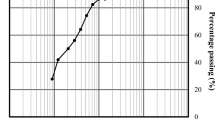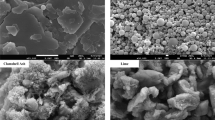Abstract
Lime Cake (precipitated calcium carbonate PCC), a by-product of sugar production, is proposed as a stabiliser for improvement of loose silty clayey loams. Two inorganic pedogenic and organic precipitated calcium carbonate polymorphs are artificially synthesized into a base loosely compacted loamy soil. Formation, micromorphology, quality of cementing bonds, and physiochemical interactions in the interlayer are modelled at molecular level and verified by a suite of micro-analytical spectrometry techniques. Emphasis is put into determining the impacts of polysaccharides on soil strength and implications on soil pore anatomy. Erodibility, compressibility, volumetric change, and hydro-mechanical behaviour of base, and modified soils at yield and post-yield states are studied. Anomalies in suction-controlled post-yield stress–strain behaviour of modified soils are discussed and explained within the tenets of mechanics of composite soils with double porosity. PCC-reinforcement offers the closest possible packing at optimum water content. Desiccation cracking remains likely, but at relatively higher lower-bound water contents. Under low confinement levels and unsaturated state, strain-hardening prevails. Loss of shear strength on saturation is minimal. When saturated, PCC-reinforced soil develops substantially high levels of shear strength at all strain levels. Higher levels of confinement are needed for organic fibrous and onion-skin coating matters to effectively encrust the soil pore network; such high levels, however, leads to formation of an unwelcomed brittle, strain–softening stress–stress behaviour.











Similar content being viewed by others

References
Chen FH (1988) Foundations on expansive soils, 2nd edn. Elsevier Scientific Publishing, Amsterdam
Houston SL, Dye HB, Zapata CE, Walsh KD, Houston WN (2011) Study of expansive soils and residential foundations on expansive soils in Arizona. J Perform Constr Facil 25(1):31–44
Petry TM, Little DN (2002) Review of stabilization of clays and expansive soils in pavement and lightly loaded structures history, practice and future. J Mater Civ Eng 14(6):447–460
Mirzababaei M, Arulrajah A, Ouston M (2017) Polymers for stabilization of soft clay. Proc Eng 189:25–32
Little D (1995) Handbook for stabilization of pavement subgrade and base courses with lime. Kendall Hunt, Dubuque
Broms BB, Boman P (1977) Lime columns - a new type of vertical drain. In: Proceedings of the 9th international conference of soil mechanics and foundation engineering, vol 1, Tokyo, pp 427–432
Van Olphen H (1977) An introduction to clay colloid chemistry, for clay technologists, geologists, and soil scientist. Wiley, New York
Bell FG (1989) Lime stabilisation of clay soils. Bull Int Assoc Eng Geol 39(1):67–74
Rogers CFG, Glendinning S (1997) Improvement of clay soils in situ using lime piles in the UK. Eng Geol 47:243–257
Beetham P, Dijkstra T, Dixon N, Fleming P, Hutchison R, Bateman J (2015) Lime stabilisation for earthworks: a UK perspective. Proc Inst Civil Eng Ground Improv 168(GI2):81–95
Norra S, Fjer N, Li F, Chu X, Xie X, Stuben D (2008) The influence of different land uses on mineralogical and chemical composition and hirozonation of urban soil profiles in Qingdao, China. J Soil Sediments 8(1):4–16
Santos RM, Georgakopoulos E, Manovic V, Chiang YW (2016) Producing value-added mineral products from metallurgical slag. In: Canadian chemical engineering conference, Quebec
El-Sherbiny S, El-Sheikh SM, Barhoum A (2015) Preparation and modification of nano calcium carbonate filler from waste marble dust and commercial limestone for papermaking end application. Powder Technol 279:290–300
Zhang H, Chen JF, Zhou HK, Wang GQ, Yun J (2002) preparation of nano-sized precipitated calcium carbonate for pvc plastisol rheology modification. J Mater Sci Lett 21(16):1305–1306
Valencia D and Calapini SA (2004) Powdered beverage mix with rapidly dissolving calcium. US Patent 6(833):146
Kreklau B, Sittinger M, Mensing MB, Voigt C, Berger G, Burmester GR, Rahmanzadeh R, Gross U (1999) Tissue engineering of biphasic joint cartilage transplants. Biomaterials 20(18):1743–1749
Shoira M (2006) Application of defecation lime from sugar industry in Uzbekistan. Industrial Ecology Royal Institute of Technology, Stockholm, Sweden
Hanks DA, Shaw D (2008) Precipitated calcium carbonate (PCC) from sugar processing by products for use in cementitious applications and methods thereof. United States Patent US2008/0210134 A1.
Inkret JM (1996) Effects of precipitated calcium carbonate from sugar purification on crusting soils. Montana State University
Palomino AM, Burns SE, Santamarina JC (2008) Mixtures of fine-grained minerals—kaolinite and carbonate grains. Clays Clay Miner 56(6):599–611
Assadi-Langroudi A, Jefferson I (2013) Collapsibility in calcareous clayey loess: a factor of stress-hydraulic history. Int J Geomate 5(1):620–627
Ismail MA, Joer HA, Sim WH, Randolph MF (2002) Effect of cement type on shear behavior of cemented calcareous soil. J Geotech Geoenviron Eng 128(6):520–529
Fredlund DG, Xing A (1994) Equations for the soil-water characteristic curve. Can Geotech J 31:521–532
Van Genuchten MT (1980) A closed-form equation for predicting the hydraulic conductivity of unsaturated soils. Soil Sci Soc Am J 44:892–898
Zhang X, Mavroulidov M, Gunn MJ (2017) A study of the water retention curve of lime-treated London Clay. Acta Geotech 12:23–45
Arya LM, Leij F, Van Genuchten MT, Shouse PJ (1999) Scaling parameter to predict the soil water characteristic from particle-size distribution data. Soil Sci Soc Am J 63:210–519
Arya LM, Paris JF (1981) A physicoempirical model to predict the soil moisture characteristic from particle-size distribution and bulk density data. Soil Sci Soc Am J 45:1023–1030
Haverkamp R, Parlange JY (1982) Comments on: a physicoempirical model to predict the soil moisture characteristic from particle-size distribution and bulk density data. Soil Sci Soc Am J 46:1348–1349
Arya LM, Paris JF (1982) Reply to comments on a physicoempirical model to predict the soil moisture characteristic from particle-size distribution and bulk density data. Soil Sci Soc Am J 46:1348–1349
Assadi-Langroudi A, Jefferson I (2016) The response of reworked aerosols to climate through estimation of inter-particle forces. Int J Environ Sci Technol 13(4):1159–1168
Assadi-Langroudi A, Ng'ambi S, Smalley I (2018) Loess as a collapsible soil: some basic particle packing aspects. Quat Int 469(A):20–29
Assadi-Langroudi A (2014) Micromechanics of collapse in Loess. University of Birmingham, England
Bagherieh AR, Khalili N, Habibagahi G, Ghahramani A (2009) Drying Response and Effective Stress in a Double Porosity Aggregated Soil. Eng Geol 105:44–50
Author information
Authors and Affiliations
Corresponding author
Additional information
Publisher's Note
Springer Nature remains neutral with regard to jurisdictional claims in published maps and institutional affiliations.
Rights and permissions
About this article
Cite this article
Assadi Langroudi, A., Ghadr, S., Theron, E. et al. Lime Cake as an Alternative Stabiliser for Loose Clayey Loams. Int. J. of Geosynth. and Ground Eng. 5, 22 (2019). https://doi.org/10.1007/s40891-019-0173-y
Received:
Accepted:
Published:
DOI: https://doi.org/10.1007/s40891-019-0173-y



